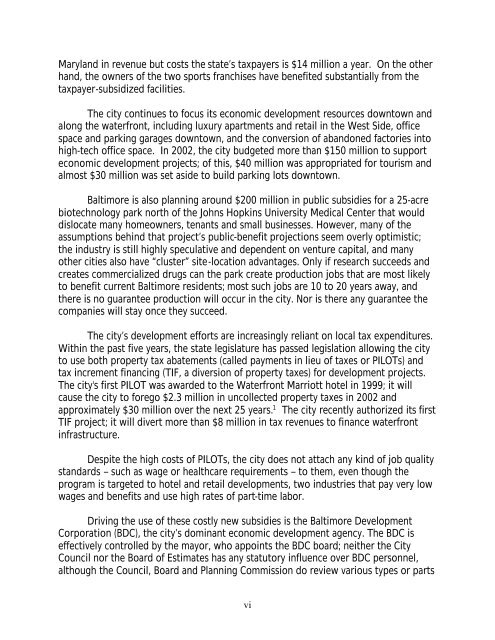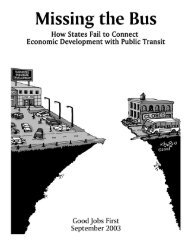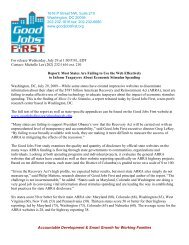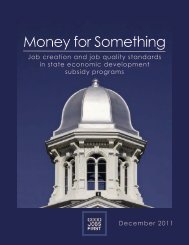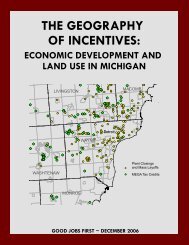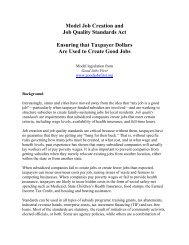Subsidizing the Low Road: Economic ... - Good Jobs First
Subsidizing the Low Road: Economic ... - Good Jobs First
Subsidizing the Low Road: Economic ... - Good Jobs First
Create successful ePaper yourself
Turn your PDF publications into a flip-book with our unique Google optimized e-Paper software.
Maryland in revenue but costs <strong>the</strong> state’s taxpayers is $14 million a year. On <strong>the</strong> o<strong>the</strong>rhand, <strong>the</strong> owners of <strong>the</strong> two sports franchises have benefited substantially from <strong>the</strong>taxpayer-subsidized facilities.The city continues to focus its economic development resources downtown andalong <strong>the</strong> waterfront, including luxury apartments and retail in <strong>the</strong> West Side, officespace and parking garages downtown, and <strong>the</strong> conversion of abandoned factories intohigh-tech office space. In 2002, <strong>the</strong> city budgeted more than $150 million to supporteconomic development projects; of this, $40 million was appropriated for tourism andalmost $30 million was set aside to build parking lots downtown.Baltimore is also planning around $200 million in public subsidies for a 25-acrebiotechnology park north of <strong>the</strong> Johns Hopkins University Medical Center that woulddislocate many homeowners, tenants and small businesses. However, many of <strong>the</strong>assumptions behind that project’s public-benefit projections seem overly optimistic;<strong>the</strong> industry is still highly speculative and dependent on venture capital, and manyo<strong>the</strong>r cities also have “cluster” site-location advantages. Only if research succeeds andcreates commercialized drugs can <strong>the</strong> park create production jobs that are most likelyto benefit current Baltimore residents; most such jobs are 10 to 20 years away, and<strong>the</strong>re is no guarantee production will occur in <strong>the</strong> city. Nor is <strong>the</strong>re any guarantee <strong>the</strong>companies will stay once <strong>the</strong>y succeed.The city’s development efforts are increasingly reliant on local tax expenditures.Within <strong>the</strong> past five years, <strong>the</strong> state legislature has passed legislation allowing <strong>the</strong> cityto use both property tax abatements (called payments in lieu of taxes or PILOTs) andtax increment financing (TIF, a diversion of property taxes) for development projects.The city's first PILOT was awarded to <strong>the</strong> Waterfront Marriott hotel in 1999; it willcause <strong>the</strong> city to forego $2.3 million in uncollected property taxes in 2002 andapproximately $30 million over <strong>the</strong> next 25 years. 1 The city recently authorized its firstTIF project; it will divert more than $8 million in tax revenues to finance waterfrontinfrastructure.Despite <strong>the</strong> high costs of PILOTs, <strong>the</strong> city does not attach any kind of job qualitystandards – such as wage or healthcare requirements – to <strong>the</strong>m, even though <strong>the</strong>program is targeted to hotel and retail developments, two industries that pay very lowwages and benefits and use high rates of part-time labor.Driving <strong>the</strong> use of <strong>the</strong>se costly new subsidies is <strong>the</strong> Baltimore DevelopmentCorporation (BDC), <strong>the</strong> city’s dominant economic development agency. The BDC iseffectively controlled by <strong>the</strong> mayor, who appoints <strong>the</strong> BDC board; nei<strong>the</strong>r <strong>the</strong> CityCouncil nor <strong>the</strong> Board of Estimates has any statutory influence over BDC personnel,although <strong>the</strong> Council, Board and Planning Commission do review various types or partsvi


